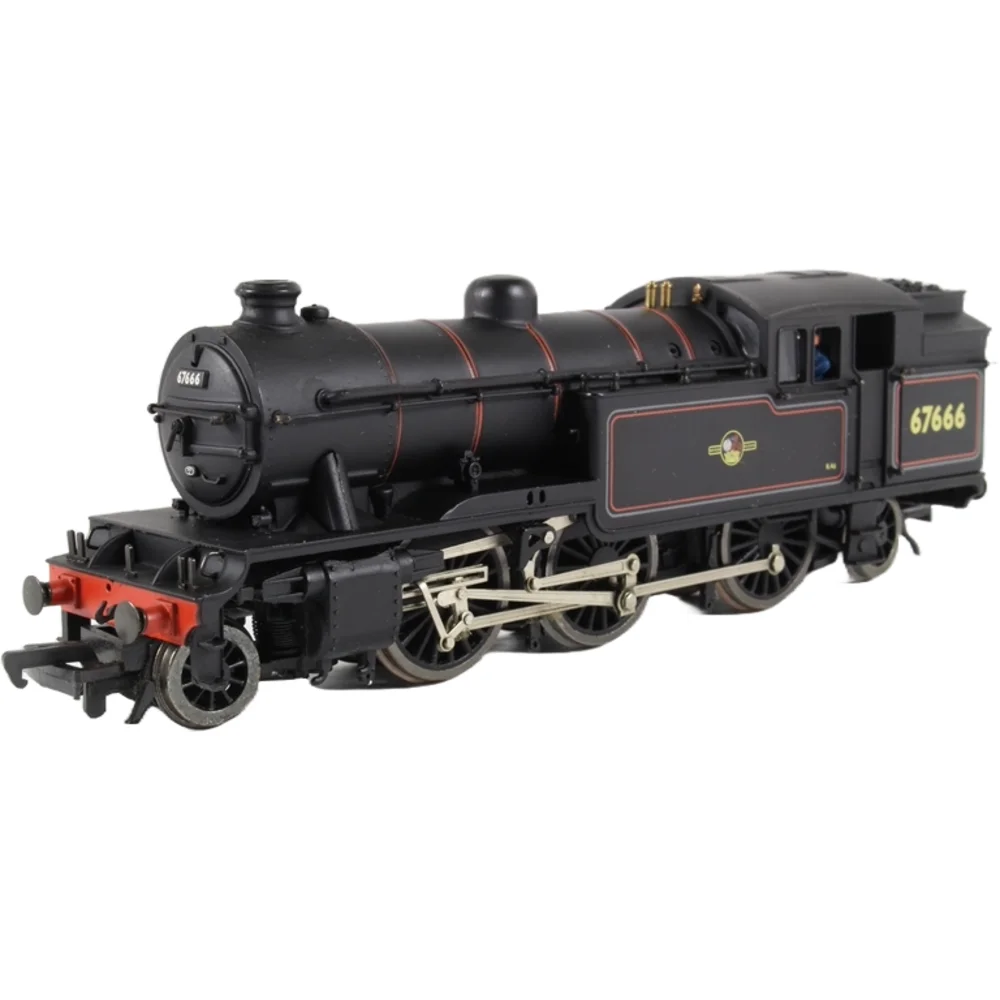Bachmann 31-604
London & North Eastern Railway V3 67666 British Railways Black with Late Crest
Tooling
The Bachmann Branchline V1/V3 2-6-2T was introduced in 1991–92 as part of Bachmann’s early OO gauge range following their acquisition of Mainline tooling. These suburban tank locomotives, designed by Sir Nigel Gresley for the LNER, were popular for their versatility on passenger and mixed-traffic duties. At the time, the model represented a significant step forward in British RTR steam locomotives, though it retained the split-chassis technology typical of the era.
Tooling Features
- Scale: OO gauge (1:76), designed for 16.5mm track.
- Construction: Plastic bodyshell with moulded details; cab glazing was basic and recessed.
- Detailing: Integral handrails, moulded rivets, and simplified pipework. No separately fitted parts typical of later “super-detail” models.
- Couplings: Tension-lock couplers mounted on the chassis; no NEM pockets.
Mechanical & Electrical
- Chassis: Split-chassis design with electrical pickup through the chassis halves.
- Motor: Mabuchi FK130 can motor driving the centre axle via gears; praised for longevity.
- Drive: All three driving axles powered; reasonable haulage for its size.
- Minimum Radius: Recommended 2nd radius (approx. 438mm).
- Lighting: None.
- Weighting: Moderate weight from chassis block; adequate for suburban trains.
DCC Capability
Not DCC-ready. Hard-wiring a decoder was considered impractical due to the split-chassis design, making conversion difficult and rarely attempted.
Liveries Produced
- LNER Apple Green (1923–1947)
- LNER Black (1923–1947)
- BR Plain Black (1948–1980)
- BR Green with Early Emblem (1948–1957)
- BR Black with Early Emblem (1949–1957)
- BR Black with Late Crest (1957–1968)
Reviews & Commentary
At launch, the model was considered robust and good value, though detailing was basic compared to later standards. Enthusiasts praised its running qualities when new, but over time issues emerged:
- Strengths: Smooth running when well-maintained; durable motor.
- Weaknesses: Vulnerable to split-chassis deterioration (cracked plastic muffs, worn plating); poor cab detail; heavy moulded features.
Modern reviewers often describe it as “outdated but nostalgic,” noting its place between Airfix-era tooling and contemporary super-detail models.
Media & Social Media
Video reviews and forum discussions highlight the model’s historical significance and mechanical reliability, but caution against second-hand purchases due to age-related failures. Popular YouTube channels have featured the V1/V3, often labelling it “worst detail but best runner” among older Bachmann tanks.
Interesting Notes
- The tooling remained in production until the mid-2000s before being replaced by a fully retooled version in 2016.
- Collectors value mint boxed examples for nostalgia rather than operational use.
Class & Prototype
- Class: London & North Eastern Railway V3
- Traction: Steam
- Built: 1939-1940
- Total Built: 10
No prototype found.
Operator & Livery
- Operator: British Railways
- Livery: Black with Late Crest
British Railways transformed Britain's fragmented rail network into a unified national system following nationalisation on 1st January 1948. Created from the "Big Four" companies under the Transport Act 1947, BR operated most of Great Britain's railways until rebranding as British Rail in 1965, managing over 20,000 route miles and inheriting nearly 20,000 locomotives of diverse designs.
The organisation pioneered standardisation through its revolutionary BR Standard locomotive programme (1951-1960), producing 999 advanced steam engines under Robert Riddles' direction. These included the versatile Britannia Pacifics, mighty 9F freight engines, and mixed-traffic classes that incorporated the best features from all predecessor companies. The 1955 Modernisation Plan accelerated diesel and electric traction development, creating fascinating mixed-traction operations.
Notable achievements included establishing unified locomotive classification systems, introducing distinctive corporate liveries, and managing the complex transition from steam to modern traction. BR's six regional structure preserved operational diversity whilst enabling standardisation of practices, signalling, and rolling stock that had eluded private enterprise for over a century.
The BR era represents steam traction's final flowering alongside emerging diesel technology, creating unparalleled locomotive variety. Today, this heritage remains highly popular with railway enthusiasts through extensive preserved fleets, heritage railway operations, and comprehensive model ranges from manufacturers like Hornby, Bachmann, and Dapol, making BR subjects essential for authentic post-war British railway modelling across all scales.
British Railways' plain black livery remained the standard finish for freight and shunting locomotives from 1956 onwards, representing the most economical and practical scheme for inherently dirty industrial operations. Plain black locomotives retained red buffer beams and received white lettering in Gill Sans style, maintaining the utilitarian approach established in the early BR period. The livery was applied to a vast range of locomotive types, from powerful freight engines like the 9F class down to humble shunting locomotives and industrial engines working in goods yards, collieries, and freight terminals.
From 1956, these locomotives received the new "Lion and Crown" emblem (nicknamed the "Ferret and Dartboard"), a proper heraldic device featuring a rampant lion emerging from a crown and holding a spoked wheel, enclosed in a roundel with "British Railways" displayed on bars either side. Unlike earlier practice, the new emblem was positioned centrally on tender sides or tank sides without reference to axle boxes, following heraldic conventions with the lion facing left. This livery period coincided with increasing neglect as steam operations wound down, with locomotives often covered in layers of grime that obscured the paintwork and made the already austere black finish appear even more weathered. The plain black finish continued until individual locomotives were withdrawn from service, with many examples lasting into the final years of steam operation in 1968. For modellers, this livery represents the twilight of steam freight operations, capturing the workaday reality of British Railways' industrial locomotive fleet during the final phase of steam traction.
